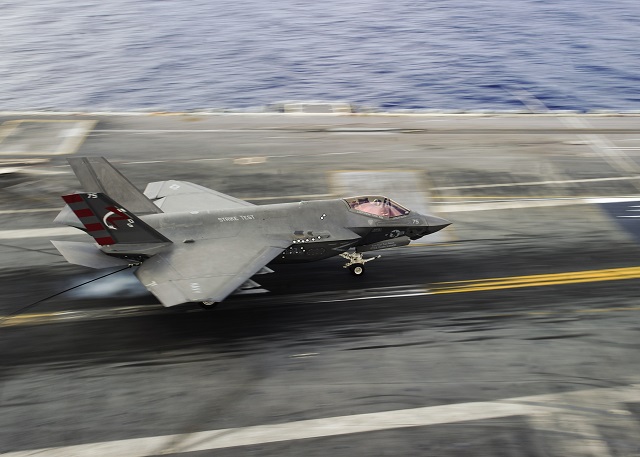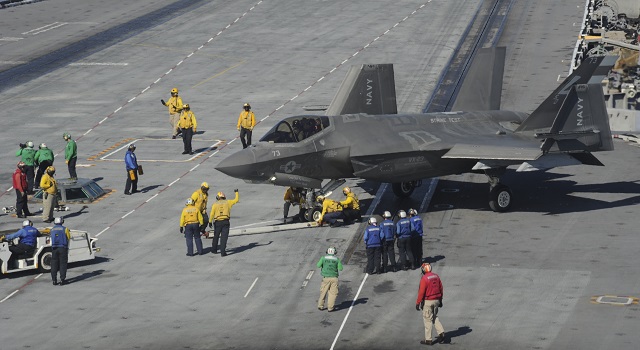 ATLANTIC OCEAN (Aug. 15, 2016) An F-35C Lightning II carrier variant, assigned to the Salty Dogs of Air Test and Evaluation Squadron (VX) 23, lands on the flight deck of the aircraft carrier USS George Washington (CVN 73). VX-23 is conducting its third and final developmental test (DT-III) phase aboard George Washington in the Atlantic Ocean. The F-35C is expected to be Fleet operational in 2018. (U.S. Navy photo by Mass Communication Specialist 3rd Class Wyatt L. Anthony/Released) |
|||
“Sensor-fusion,”
said Sylvia Pierson, F-35 Lightning II Joint Program Office/Naval Variants
Public Affairs Officer. “The full complement of F-35 sensors delivers
a spherical view of the battlespace that equips the pilot, the commander
at sea, and the commander on the ground with information from many sources
and enables the carrier strike group and joint force to make critical
decisions based upon that information. The aircraft combines this sensing
capability with the Navy’s first stealth at-sea to see adversaries
first, take decisive action, and come home safely. Overall, this fusion
of information that is shared by the pilot with those on the ground and
on the sea is a game-changer.” Courtesy of Lockheed Martin, the F-35 Lightning II combines advanced stealth technology with strike fighter maneuverability and innovative communications with an information infrastructure designed to generate a user-friendly maintenance program. “We test to make sure the aircraft meets all the specifications, and we test in the at-sea environment across the spectrum of operations the aircraft will be called upon to perform,” said Pierson. “When the aircraft is declared ready for combat operations and a squadron takes it on deployment, the warfighter can rest assured that every scenario in which they could possibly fly has already been tested by the Pax River Integrated Test Force.” “Somebody may launch with all their weapons but they may land asymmetrical. We are testing for symmetric and asymmetric loads. We test different weights, in terms of fuel and weapons. We test in crosswind conditions and evaluate the aircraft with regard to the movement of air around the island. We conduct a lot of testing at Naval Air Station Patuxent River, Md., but you can’t replicate the carrier environment.” |
|||
 ATLANTIC OCEAN (Aug. 14, 2016) An F-35C Lightning II carrier variant, assigned to the Salty Dogs of Air Test and Evaluation Squadron (VX) 23, taxis on the flight deck of the aircraft carrier USS George Washington (CVN 73). VX-23 is conducting its third and final developmental test (DT-III) phase aboard George Washington in the Atlantic Ocean. The F-35C is expected to be Fleet operational in 2018. U.S. Navy photo by Mass Communication Specialist 3rd Class Alora R. Blosch (Released) |
|||
The testing
is the final at-sea stage in preparation of the initial operational capability
(IOC) slated for 2018. “May of 2013 the Marine Corps told Congress, ‘we want to declare IOC for the F-35B in July of 2015,’” said Pierson. “July 31, 2015 we had completed all the testing of the aircraft and the Marine Corps was satisfied with all of our testing. They were able to determine the F-35B was ready for operational capability in the same month they projected two years prior. The Air Force declared IOC of their aircraft (F-35A) this summer (2016).” Each variant of the F-35 has been successful in completing all of their milestones and the carrier variant, F-35C, is on target to do so by 2018. “Prior to DT-I, the first developmental test phase at sea, the team determined that the tailhook required a redesign. Together they identified the problem, designed and tested a solution, and it worked,” said Pierson. “The aircraft conducted 124 catapult launches, 124 arrested landings, experienced no unintentional bolters, and was a three-wire machine. We had such confidence in the aircraft that we even conducted night operations for the first time during DT-I since the F-4 era. Ultimately, that’s what we are here to do with the aircraft. The manufacturer builds the aircraft, and the Navy, as a customer, has to go test drive it, to make sure that it does everything that it is supposed to do.” |
|||
U.S. Navy F-35C Begin Final Round of Sea Trials Aboard Aircraft Carrier USS George Washington
- Posted On










